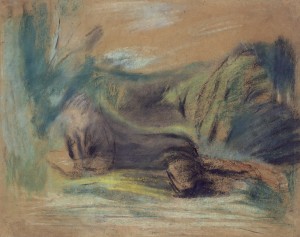In 1920, Koroteev enrolled in classes at the Artistic and Production Print Workshops operating under the First Standard Print Shop, which in the recent past was the I. D. Sytin Association print shop in Moscow. That is where he met L. F. Zheginym, who became his teacher, mentor and, later, close friend to the end of his days. Lev Fyodorovich, like the other teachers at the workshops (N. M. Chernyshyov, S. V. Gerasimov and M. S. Rodionov) was part of the “Art is Life” Artists’ and Poets’ Union. M. A. Dobrov, who taught drawing, was not a member of the Union, but was nevertheless closely associated with the circle of artists that formed it.
In the history of post-revolutionary Russian art there is no other artistic association so ahead of its time or so independent of artistic trends and the political environment. Better known as Makovets, the name of the journal they published, the Union brought together outstanding masters, each distinct from the next, based on the idea of the birth of a new, spiritual world culture and painting’s foremost significance therein as a part of cultural tradition and its rediscovery. It united them based on the idea of a new form of painting that would arise under the critical and analytical concepts of the leftist currents of the first decade of the twentieth century and that would, along with physics, mathematics, philosophy and modern theology, become a means for learning about the world; this new form of painting would become a means of reviving the cultural memory and the connection with art that had shaped Europe’s cultural landscape three, five and seven hundred years ago.
“Our art flows from the passionate demands of the soul, which must bring together isolated beams of light that are scattered by the reflective mind of modernity. We see the end of analytic art and our task is to gather it in a powerful synthesis. […] We suggest that the rebirth of art is possible only in the case of strict continuity with the masters of the past and unconditional resurrection therein of a living and eternal beginning. […] A time of luminous creation is upon us, when unshakeable values are needed and when art is reborn in its endless progression. […] We believe that Russian art and Russian thought, having undergone such massive, melting disturbances as those it endured during the past decade, brings great joy to the world”; these words are from the text “Our Prologue,” which was written by V. N. Chekrygin, one of the Union’s inspiring minds, and was published in the first issue of the journal Makovets. [1].
____________________
[1] — Makovets. 1922-1926. Sbornik materialov po istorii obedineniya (Collection of Works on the History of the Association). Moscow, 1994- Pp. 55-56.



